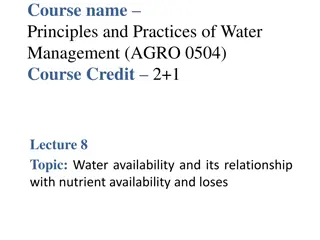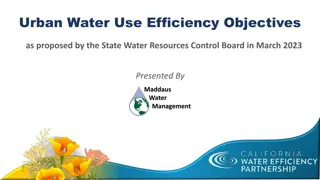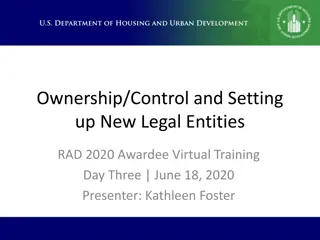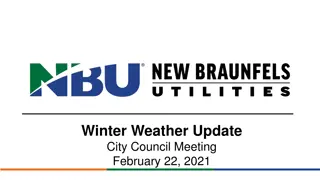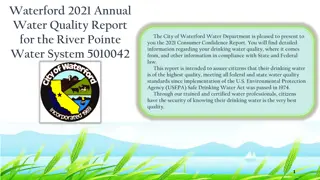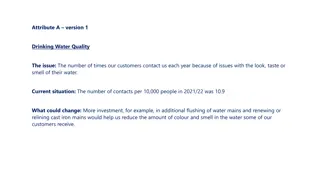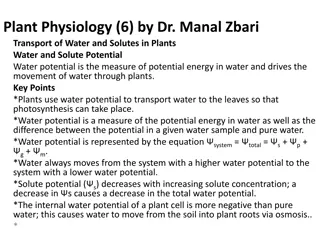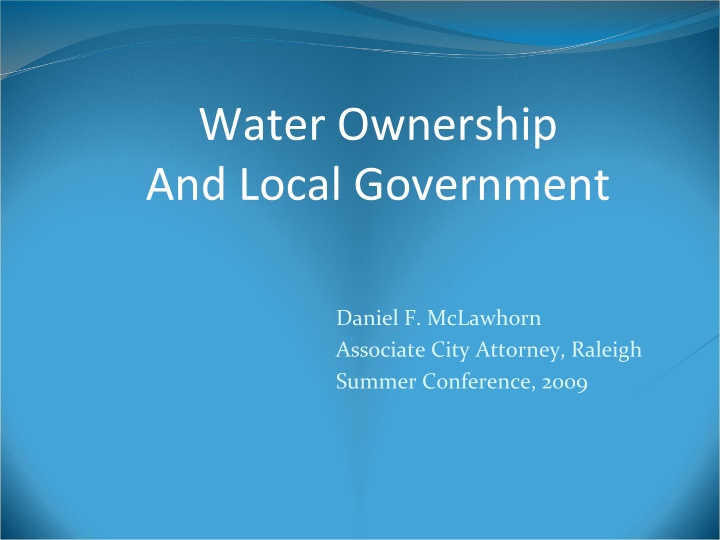
Local Government Rights and Powers Regarding Water Ownership and Regulation
Explore the legal frameworks surrounding water ownership, regulation, and conservation within North Carolina, highlighting the role of local governments in protecting clean water sources. Topics include riparian rights, governmental ownership of water, common law principles, and recent legislative developments.
Download Presentation

Please find below an Image/Link to download the presentation.
The content on the website is provided AS IS for your information and personal use only. It may not be sold, licensed, or shared on other websites without obtaining consent from the author. If you encounter any issues during the download, it is possible that the publisher has removed the file from their server.
You are allowed to download the files provided on this website for personal or commercial use, subject to the condition that they are used lawfully. All files are the property of their respective owners.
The content on the website is provided AS IS for your information and personal use only. It may not be sold, licensed, or shared on other websites without obtaining consent from the author.
E N D
Presentation Transcript
Water Ownership And Local Government Daniel F. McLawhorn Associate City Attorney, Raleigh Summer Conference, 2009
Main Question What rights and powers do local governments possess to protect and ensure reliable sources of clean water? Can a local government hold riparian rights? Can a local government own the water? Common Law Legislation
SB 907/HB 1101 The waters of the State are a natural resource owned by the State in trust for the public and subject to the sovereign power of the State to plan, regulate, and control the withdrawal and use of those waters . . . Is this a change in the law? Can legislation divest previously conferred rights in waters?
NC Constitution Art. XIV, 5. Conservation of Natural Resources It shall be the policy of this State to conserve and protect its lands and waters for the benefit of its citizenry, and to this end it shall be a proper function of the State of North Carolina and its political subdivisions to acquire and preserve park, recreational, and scenic areas, to control and limit the pollution of our air and water, . . . (1971)
Public Waters Statutes N.C.G.S. 143-212(6) (1951) Waters means any, stream . . ., reservoir, waterway or other body or accumulation of water, whether surface or underground, public or private, or natural or artificial . . . N.C.G.S. 143-211 (1967) Recognizing that the water and air resources of the State belong to the people, . . . N.C.G.S. 113-131(a) (1965) The marine and estuarine and wildlife resources of the State belong to the people of the State as a whole. N.C.G.S. 113-129(11) (1965) Marine and Estuarine Resources. All fish, . . . and the entire ecology supporting such fish, fisheries and plant and animal life. N.C.G.S. 113-129(11) (1965) Wildlife Resources. All . . . fish found in inland fishing waters. . . and the entire ecology supporting such . . . fish, plant and animal life, and creatures.
Common Law, Flowing Water No [ownership] property right in flowing water 46 N.C. L. Rev. 1, 5 (1967); citing Durham v. Cotton Mills, 141 N.C. 615 (1924); Dunlap v. Carolina Power & Light Co., 212 N.C. 814 (1938). Municipal diversion of water for water supply can result in compensable harm to riparian rights of downstream owner. Pernell v. Henderson, 220 N.C. 79 (1941); Geer v. Durham Water Co., 127 N.C. 349 (1900). Riparian easement for reasonable use of flow and use long recognized. Biddix v. Henredon Furniture Industries, Inc., 76 N.C. App. 30 (1985).
Common Law, Groundwater Reasonable use rule applies. The owner who withdraws can use as required to support activity on the overlying property. Withdrawal of percolating groundwater for sale by city resulted in compensable trespass to another overlying owner who relied on same waters for in situ use. Rouse v. City of Kinston, 188 N.C. 1 (1924). Withdrawal and diversion to facilitate mining is a reasonable use. Bayer v. Nello L. Teer Co., 256 N.C. 509 (1962).
Common Law, Impounded Water Owner of stream bed controls the waters. Steel Creek Development Corp. v. James, 58 N.C. App. 506, 512 (1982). Municipal impoundments subject to riparian rights of downstream owner. Pernell v. Henderson, 220 N.C . 79 (1941); Geer v. Durham Water Co., 127 N.C. 349 (1900). Easement by necessity to maintain impoundment for mill power does not ripen to title to bed . Latta v. Catawba Electric & Power Co., 146 N.C. 285 (1907); Bowling v. Burton, 101 N.C. 176, (1888).
Withdrawal Statutes N.C.G.S. 143-215.44 (1971): (a) A person who lawfully impounds water for the purpose of withdrawal shall have a right of withdrawal of excess volume of water attributable to the impoundment. (b) Right of withdrawal - right to excess volume (c) Excess Volume - volume that may be withdrawn directly from or below the impoundment without reducing flow below its natural, undammed level (d) Impound - financing/promising to finance construction or operation of dam impoundment.
Withdrawal Statutes N.C.G.S. 143-215.46: A person may exercise the right of withdrawal by withdrawing directly from the impoundment, from a watercourse below the impoundment, or both . . . N.C.G.S. 143-215.49: A person operating a municipal . . . water system and having a right of withdrawal may assert that right when its withdrawal is for use in any such water system as well as in other circumstances.
EMC Allocation Power N.C.G.S. 143-354(a)(11): The Commission is authorized to assign or transfer to any county or municipality or other local government having a need for water supply storage in federal projects any interest held by the State in such storage, upon the assumption of repayment obligation thereof, or compensation to the State, by such local government.
Common Law - Legislative Allocation of Public Trust For the foregoing reasons, we conclude that the General Assembly is not prohibited by our laws or Constitution from conveying in fee simple lands underlying waters that are navigable in law without reserving public trust rights. The General Assembly has the power to convey such lands, but under the public trust doctrine it will be presumed not to have done so. That presumption is rebutted by a special grant of the General Assembly conveying the lands in question free of all public trust rights, but only if the special grant does so in the clearest and most express terms. Gwathmey v. State, 342 N.C. 287, 304 (1995)
Riparian Rights 1) The right to be and remain a riparian proprietor and to enjoy the natural advantage thereby conferred upon the land by its adjacency to the water. 2) The right of access to the water, including a right of way to and from the navigable parts. 3) The right to build a pier or wharf out to the navigable water, subject to any regulations by the State. 4) The right to accretions or alluvium. 5) To make reasonable use of the water as it flows past or laves the shore. Matter of Mason ex rel. Huber, 78 N.C. App. 16, 25 (1985)
No Reasonable Use Doctrine Reasonable use exemption relies on takings power of eminent domain entities. Bd. Of Trans. v. Terminal Warehouse Corp., 300 N.C. 700 (1980). Only State can bring action for injury to public trust waters. Neuse River Found. v. Smithfield Foods, Inc., 155 N.C. App. 110 (2002). Downstream riparian owner can sue for damages from unreasonable upstream riparian use, including water diversion for drinking water supply. Geer v. Durham Water Co., 127 N.C. 349 (1900); Cook v. Town of Mebane, 191 N.C. 1 (1926);Whiteside, Inc. v. Highland, Inc., 146 N.C. App. 449 (2001). No rights by prescription to maintain a nuisance. Shelby v. Cleveland Mill, 155 N.C. 196 (1911); Bd of Health v. Louisburg, 173 N.C. 250 (1917).
Example One City A s Riparian Park Utility B s Intake
QUESTIONS Do local governments have standing to seek protections under the reasonable use doctrine, or through strict liability, for injuries to riparian lands, such as city-owned parks, by upstream eminent domain entities? Is the reasonable use doctrine expanded by the statutory minimum flow standards such as the CWA? Can riparian rights to use and flow be divested by prescription?
Common Law, Flowing Water . . . a municipal corporation can not, as riparian owner, claim the right to supply the needs of its inhabitants from the stream. Pernell v. Henderson, 220 N.C. 79 (1941) BUT Municipal corporations have the same rights as individuals and private corporations to battle for justice and equality of opportunity . . . Elizabeth City Water & Power Co. v. Elizabeth City, 124 S.E. 611 (1924)
Questions Do local governments have standing to seek protections under reasonable use doctrine, or strict liability, for injuries by upstream eminent domain entities to riparian parks, for example? See Elizabeth City Water & Power Co. v. Elizabeth City, 124 S.E. 611 (1924) ( Municipal corporations have the same rights as individuals and private corporations to battle for justice and equality of opportunity . . . ); Durham v. Cotton Mills, 141 N.C. 615 (1924) (riparian rights don t extend to protect use by non-riparian owners) Is the reasonable use doctrine expanded by CWA, ESA, etc. standards for minimum flow? SeeBiddix v. Henredon Furniture Industries, Inc., 76 N.C. App. 30 (1985) (NPDES permit = reasonable use). Can riparian rights to use and flow be divested by prescription? SeeDurham v. Cotton Mills, 141 N.C. 615 (1924) (If so, only by a riparian owner for on site use)




